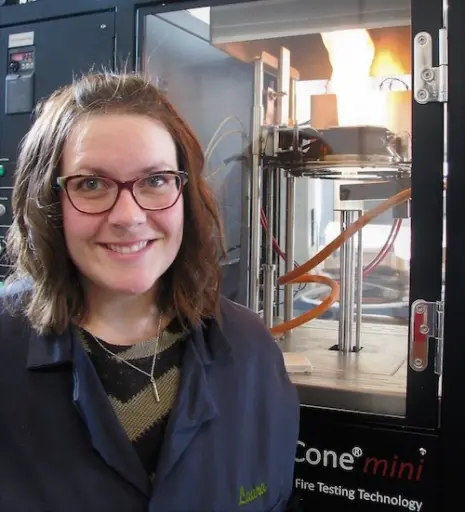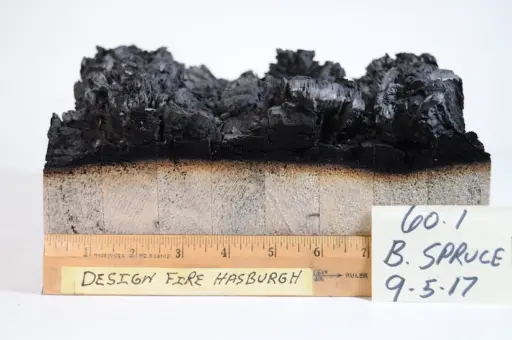The 2021 International Building Code will contain new standards for using an engineered wood product known as cross-laminated timber in taller buildings than ever before.
 Laura Hasburgh running a test in the cone calorimeter at FPL.
Laura Hasburgh running a test in the cone calorimeter at FPL.
They’re standards informed, in large part, by research conducted by Laura Hasburgh, a technical staff member of the USDA Forest Service’s Forest Products Laboratory (FPL) in Madison, Wisconsin, and a PhD student in materials science and engineering at the University of Wisconsin-Madison.
Essentially, Hasburgh researches how wood interacts with fire. At FPL, she studies the combustion of wood and engineered wood products in buildings, while as a graduate student, she examines the chemical, physical, structural and mechanical changes that take place when wood burns. For example, she has conducted extensive testing to determine the charring rates of six wood species—Douglas fir, southern yellow pine, redwood, black spruce, red oak and maple—commonly used as building materials. Char rates inform building code decisions about how to size wood structural members so that they maintain their strength in a fire long enough to give occupants time to exit or rescue personnel time to enter a burning building.
“Laura’s graduate research has important practical implications for the design of modern buildings for fire safety, for the design of fire-safe wooden structures such as decks at the urban-wildland interface, and for the protection of firefighters who enter burning structures to save lives,” says Don Stone, a professor of materials science and engineering at UW-Madison who is Hasburgh’s advisor.
An engineered wood product made by gluing together perpendicular layers of solid-sawn lumber, cross-laminated timber is a sustainable, ultra-strong and aesthetically pleasing alternative to concrete and steel, which require massive amounts of energy to produce and transport.
Over the past two decades, this engineered timber has become increasingly popular in the United States as a structural material in “short” residential and commercial wood buildings, which are limited by building code to six stories.
The International Code Council develops the base construction and public safety code used in the United States as well as countries worldwide. Recognizing the potential of these advanced wood-based structural systems for much taller buildings, the council convened a Tall Wood Buildings Committee in 2015 to study the feasibility of and to take action on updating the code for wood structures taller than six stories.
 Laura Hasburgh has conducted extensive testing to determine the charring rates of six wood species, including black spruce.
Laura Hasburgh has conducted extensive testing to determine the charring rates of six wood species, including black spruce.
“There’s understandably a great deal of concern, especially when you take a combustible product and use it in a high-rise,” said committee chair Stephen DiGiovanni in the October 2018 story, “Support for tall timber reaches new heights in building code,” in Architect magazine. “As chair, I have to take as neutral an approach as possible, but if I leaned any way, it was to make sure the fire services issues were addressed.”
Setting a series of test fires, Hasburgh and her FPL colleagues addressed those issues in a big way. In summer 2017, they conducted five large-scale fire experiments in a highly instrumented, fully furnished two-story apartment structure built with cross-laminated timber at the U.S. Alcohol, Tobacco, Firearms and Explosives Research Laboratory in Beltsville, Maryland.
The team varied the conditions for each test—from covering the wood with gypsum and exposing some of the walls or ceilings to adding sprinkler systems that responded immediately or experienced an intentional delay. From those tests, the researchers learned how much varying levels of exposed engineered wood contributed to the overall fire and how much charring damage, if any, the wood itself sustained. They also learned how the fire grew, spread and decayed, as well as how much heat it released, where that heat traveled throughout the structure, and how much time it took to extinguish the fire.
This new understanding of how mass timber buildings perform during a fire convinced members of the Tall Wood Structures Committee to update the 2021 building code to reflect the ways in which it is possible to build safe, taller structures with engineered wood.
Hasburgh’s undergraduate degree is in architectural engineering and building construction and master’s degree is in fire protection engineering, and she worked as a fire protection engineer and consultant before joining FPL and entering her PhD program at UW-Madison. She says a fire protection course she took as an undergraduate influenced the direction of her professional and academic careers. “It’s a fun and innovative way to be at the forefront of the field,” she says. “I enjoy the life safety and human aspect. Rather than applying building codes as a consultant, I’m now informing decisions about them.”